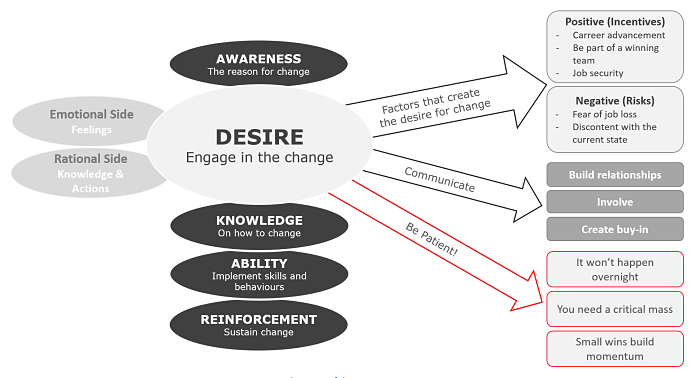Be it a digital transformation endeavor or even a smaller change project, resistance to change in the workplace is real. Overcoming resistance to change, though, shouldn’t be an everyday struggle.
Of course, you can ignore the resistance and charge ahead with the change process (no, it’s not the solution we intend to suggest). However, ignoring the resistance to change of your team won’t make the resistance disappear.
The easier way to manage and reduce resistance to change in the workplace is to create the desire for an improved future context – a better future that will be created as a result of implementing the change.
The desire for change (instead of resistance to change) is the D in the ADKAR formula for change management.
ADKAR, a model introduced by PROSCI, means Awareness, Desire, Knowledge, Ability, Reinforcement.
There are three main elements that need to be addressed if you want to create the desire for change:
1. Identify the factors that will make people desire the change instead of resisting it.
2. Communicate
3. Patience
1. Make people understand why resistance to change is not good
There are two types of factors that will help you do this:
a. Positive Factors (Incentives)
- What’s In It For Them
- The possibility of a career advancement as a result of implementing the change
- Being part of a winning team
- Job security
b. Negative Factors (Risks)
- Discontent with the current state
- Fear of job loss
2. Communicate the need for change
No, it doesn’t mean formal communication. While we agree that formal communication is needed, if the leadership wants to reduce resistance to change, formal communication is not their tool.
True communication means:
Building relationships
Involving
You not only communicate but you also listen. And while listening, try to understand what the real reasons why people resist change are.
It’s not always human nature to resist change. There may be situations when you are overlooking the risks involved by the change because you’re missing an important piece of information. Or, it may be that people resisting change lack the tools or the knowledge to perform the activities involved in the change process. Or they don’t understand the various phases of the process and their sequence. Or, so many other reasons than just being stubborn.
Creating buy-in
Leadership needs to show those involved that the change is for them and together with them.
3. Be patient
Rome was not built in a day
Overcoming resistance to change won’t happen overnight.
Build a critical mass
You will also need a critical mass of people (the early adopters) who understand the need for change and become advocates for the change. The other will follow. Slowly but surely.
Celebrate small wins
Small wins need to be celebrated. They are the stepping stones to bigger wins. They help you build momentum and make the change easier.
Things to remember:
Overcoming resistance to change is not something that you do with a formal process.
Your change management process will need to address both the emotional and the rational side:
The emotional side:
Leave reason aside and talk to people’s feelings, their fears, their reluctance. Address them with solutions.
The rational side:
- Your team needs the knowledge to understand what needs to be changed and how they need to proceed. Some types of resistance to change come from a lack of knowledge
- Your team needs the tools to implement the change. Some other times, your team has the knowledge but lacks the tools to proceed. Make sure that you listen to your team’s feedback and provide them with the tools they need to advance the process.
- Your actions: your actions should reflect your words. You need to build trust. You definitely need to walk the talk.







